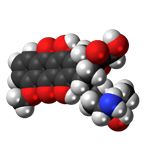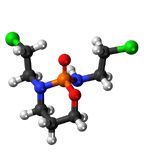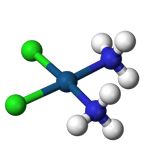Adjuvant Chemotherapy Efficacy Inconclusive in Uterine Sarcomas
The addition of adjuvant chemotherapy using doxorubicin, ifosfamide, and cisplatin, to pelvic radiation therapy for the treatment of uterine sarcomas increased 3-year disease-free survival in a group of women with localized disease, but also resulted in two toxic deaths among the study group.
The addition of adjuvant chemotherapy using doxorubicin, ifosfamide, and cisplatin, to pelvic radiation therapy for the treatment of uterine sarcomas significantly increased the 3-year disease-free survival in a group of women with localized disease, according to the results of the SARCGYN study. However, the chemotherapeutic regimen also resulted in two toxic deaths among the study group.

Space-filling model doxorubicin
Researchers, led by Patricia Pautier, MD, of the Institut Gustave-Roussy, France, concluded that the results, published in Annals of Oncology, show that the “addition of four cycles of API chemotherapy prior to adjuvant pelvic radiation therapy increases slightly the disease-free survival.” However, they also acknowledged that the associated toxicity of the treatment regimen means that the results need to be confirmed in a study with longer follow-up of the patients.

Ball-and-stick model of ifosfamide
The occurrences of uterine sarcomas are relatively rare, making up only a small percentage of all uterine malignancies. Prior studies of the disease have examined both radiation therapy and surgical approaches alone, but, according to the researchers, “whether or not adjuvant therapy has an impact on the survival of patients with uterine sarcoma is unclear.”

Ball-and-stick model of cisplatin
The SARCGYN study was a phase III trial designed to compare adjuvant chemotherapy with doxorubicin, ifosfamide, and cisplatin with subsequent radiation therapy vs radiation therapy alone in women aged 18 to 65 years with uterine sarcoma. The researchers sought to detect whether the adjuvant chemotherapy resulted in a 20% or greater increase in 3-year progression-free survival. Uterine sarcoma was defined as leiomyosarcoma, carcinosarcoma, and endometrial stromal sarcoma, according to the classification system at study commencement.
Women assigned to chemotherapy were to receive up to four cycles of doxorubicin, ifosfamide, and cisplatin administered every 3 weeks. Pelvic radiation therapy was begun 4 weeks after the last chemotherapy cycle. The second group of women, assigned to radiation alone, received radiation therapy within 8 weeks of undergoing surgery.
The trial was stopped early due to lack of enrollment. Between 2001 and 2009, researchers enrolled 81 patients at 19 institutions. The expected enrollment was 256 patients. The published results are based on the 81 women enrolled in the study through August 2009.
During the follow-up period, 41 patients had disease relapse, including 15 in the chemotherapy arm. Overall disease-free survival was 33 months. Patients assigned to chemotherapy plus radiation had a 3-year disease-free survival of 55% compared with 41% in those assigned to radiation alone (P = .0048). No difference in overall survival was seen in the study.
Patients assigned to chemotherapy who underwent at least one cycle of treatment experienced a variety of grade 3 and grade 4 toxicities, including 76% of patients who reported thrombopenia. Twenty-two percent of patients had febrile neutropenia with two toxic deaths occurring in the study arm.
Recently, uterine sarcomas have been reclassified, with carcinosarcoma being reclassified as a dedifferentiated or metaplastic form of endometrial cancer. The researchers pointed out in their discussion that this reclassification could affect the results of the study because of “the possible difference in chemosensitivity among histopathological subtypes.”
Newsletter
Stay up to date on recent advances in the multidisciplinary approach to cancer.
Sarcoma Awareness Month 2023 with Brian Van Tine, MD, PhD
August 1st 2023Brian Van Tine, MD, PhD, speaks about several agents and combination regimens that are currently under investigation in the sarcoma space, and potential next steps in research including immunotherapies and vaccine-based treatments.